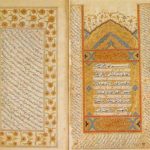
There is no doubt that long before the advent of Islam writing was the primary means of preserving and documenting contracts and covenants, and what the Qur’ān itself specifically and verbally recorded for this purpose. When we find, in point of fact, that the Prophet of Islam did not himself record his Qur’ān—the word given him by his Lord – nor his Sunna – his own word to his followers and believers in his message, it means one of two things: (1) that such a text existed but was not deemed relevant enough to be recorded; or (2) that such a text did not exist in the first place.
IN BOTH CASES the result is the same: the Prophet introduced a new religion, spent his life spreading and consolidating it, and then departed without there being something now known as ‘the Qur’ān’ or ‘the Sunnah’, because neither existed at all during his lifetime.
What is all the more starting is that Muammad’s failure to document his Lord’s words to him and his own words to his believers, overturns any claim that the Qur’ān is the word of God or that the hadiths are the words of the Prophet. It also refutes many other claims, including all those narrations concerning the revelation of verse and their abrogation, and the chains of transmission of hadiths, calibrated as ‘authentic’ or ‘weak’, ‘fabricated’ or Jewish infiltrations (the Isrā’īliyāt)[1], and so on.
However, in fact, the Text is with us today and has accompanied Islam from its earliest beginnings in an organic relationship, one in which neither can survive without the other. Even if we accept, for the sake of argument, that the Text did not actually exist at the time of the prophecy during the lifetime of the Prophet, this does not mean that the Text did not evolve and breathe life into it at some point, albeit long after the Prophet’s passing and as part of a gradual and cumulative process rather than a single miraculous event, as we might believe. How then, and when, did the Islamic religious text develop?
Muammad’s failure to document his Lord’s words to him overturns any claim that the Qur’ān is the word of God
A text is an approximate description, as far as is possible, of a past, present or future reality, a linear depiction of actual facts or relationships. This means that there must be a pre-existing physical and tangible reality before anything about it could possibly be rendered via textual or oral record or an approximate image of it conveyed one way or another. In the absence of that tangible reality, it becomes impossible to describe something that does not exist, either via a spoken or written record, or indeed by any other means.
The opposite, however, is not true, in the sense that reality exists and continues to exist whether or not there is a text to describe it or speak of it. Reality is the original source, while the text is merely a mirror and an incomplete image at best. This applies even to texts related to the unseen and to metaphysics, because while these may speak of beings and realities that do not actually exist materially in our lived world, they derive their physical existence from within our imagination. Thus we can talk about gods, demons, elves, mathematics, astronomy, stars, and many other things beyond the reach of our senses by reconstructing them within our minds from the same material components or laws that are already available within our actual tangible world, albeit in the form of conceptual theories and formations that do not really exist in our midst and may not actually exist at all.
Muḥammad was born within a cultural and religious milieu and did not emerge out of nowhere. The Quraysh worshipped God, prayed, fasted, made pilgrimages, offered sacrifices, gave charity, supplicated for rain and did everything associated with religions, their symbols, rituals, customs, traditions, and so on, without the need for a text. This is what Muḥammad lived and applied to his new religion right up to the time he died. The Quraysh recognized him and accepted his call and prophethood in their usual and customary manner, and Muḥammad therefore did not need to document this recognition and acceptance in a written text, especially given that texts of contracts, covenants and covenants were written down only in anticipation of possible disagreement and dissent, or as an instrument of submission in the event of defeat following a dispute. After his victorious return to Mecca, Muḥammad did not need such a covenant or an instrument of acquiescence from his own family and tribe, among whom he was born and raised.
‘Uthmān hastened to collect together an élite of specialists with the aim of drafting the first text (a constitution) that could avert the impending dangers
But the situation changed after the death of the Prophet and the outbreak of the ‘apostasy wars’. Tribes from outside Makka used to give zakāt to Muḥammad because he was the ‘prophet sent from God’ in whom they believed and whose message they believed. Now that Muḥammad was dead, for whom was this now to be taken and under what justification? After Muḥammad the tribes assumed they had regained their previously equal positions both with the tribes of Makka and any other Arab tribe, even if they retained Muḥammad’s religion in place of their old tribal religion. In fact, these did not renounce Muḥammad’s religion, but simply refrained from paying zakāt on the grounds that Muḥammad was now dead.
The tribes had been giving zakāt to Muḥammad as a prophet and religious symbol, not as a tribal leader of the Quraysh. What would have been the purpose of continuing to give it to someone else who lacked Muḥammad’s prophet status, his status as a religious symbol and all his qualifications to being the legitimate authority in Makka? This would simply mean losing their autonomy and becoming subject to the authority of others beyond their tribe, even if they were of the same religion. This was a huge shift in the long-standing relationship between Arab tribes and each other, and none of them would have readily accepted such a shift. At the same time, it represented a major turning point, both in the march of religion and in the relationship of Arab tribes with each other.
The ‘apostasy wars’, in the end, were essentially more an act of political dissent than religious apostasy, and they sounded the first alarm to the nascent Muslim community. It likely drew the attention of the early élite to where the peril and existential threat to the nascent group lay, and alerted them to the need to speed up the search for a cure. The alarm quickly turned into a loud siren portending a total destruction during the reign of the third caliph ‘Uthmān ibn ’Affān: an imbalance and turmoil in the legal positions of the components of the Muslim community was emerging that threatened sedition and all-out war. Perhaps this therapeutic action came somewhat late in the day and perhaps it might have been better to have corrected such an imbalance during the apostasy wars, but this corrective did come in any case.

Suggested Reading
The legitimate authority, represented by ‘Uthmān, hastened to collect together an élite of specialists with the aim of drafting the first text (a constitution) that could control the emerging relationship between its components, and thus forestall the visible danger. The Qur’ān had already been developed (or ‘collected together’ as the fuqahā’ term it) but because this move came late, this same Qur’ān may have precipitated ‘Uthmān’s own final hour and killed him in cold blood, resulting in the Muslim community exploding from within in an orgy of stabbing, killing and mutual slaughter during the so-called ‘fitna era’. Despite this, the Qur’ān of ‘Uthmān – the first ever Islamic religious text (social contract) – duly came into being. But it would not be the last and opened the door to a torrent of religious texts and literature that is gushing until now.
It is indisputable that the group entrusted with the task of ‘collecting together’ the Qur’ān had to be subject to certain considerations governing their work. At the forefront of these was the selection and commissioning body – which ‘Uthmān himself headed as the legal caliph (lit. ‘successor’). These considerations perforce included research and exploration of everything emanating from the Prophet during his lifetime – all the words, deeds, customs and habits – as the principal symbol and ritual for the Text they were drafting, describing him and documenting him.
In conclusion, the Text in its final version had to meet two basic conditions: (1) it had to be approved by the authority that was entrusting them with the task; and (2) it had to be widely accepted by the Muslim community, not necessarily by all its components. But the evidence indicates, however, that this second condition was not fulfilled as required, as illustrated by the death of the caliph himself, the outbreak of the wars of sedition and the multiplicity of Qur’āns that existed in parallel with the Qur’ān of ‘Uthmān.
Thus, the first basic system (the constitution/Qur’ān) in Islam was established, later to be supplemented from time to time by appendices, commentaries, analogies, interpretations, legal schools, madrasas, fatwās, ijtihād and the consensus of scholars up to the present day.
[1] On this, see Almuslih article: The meaning of the term ‘Israiliyat’

